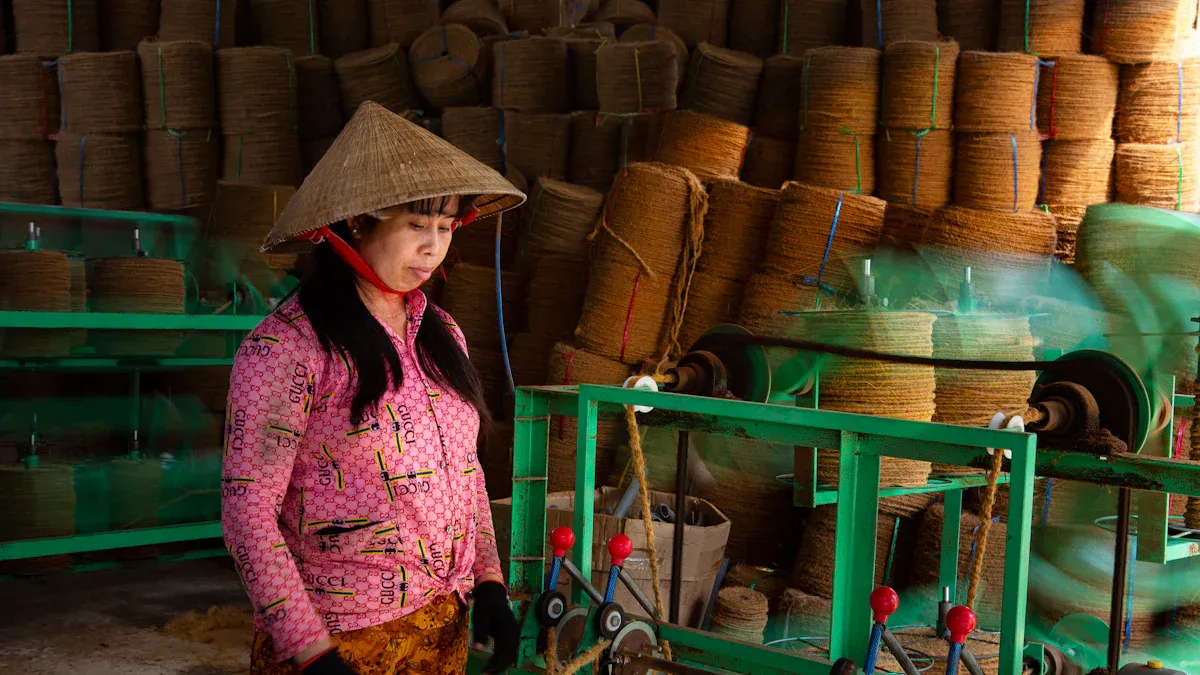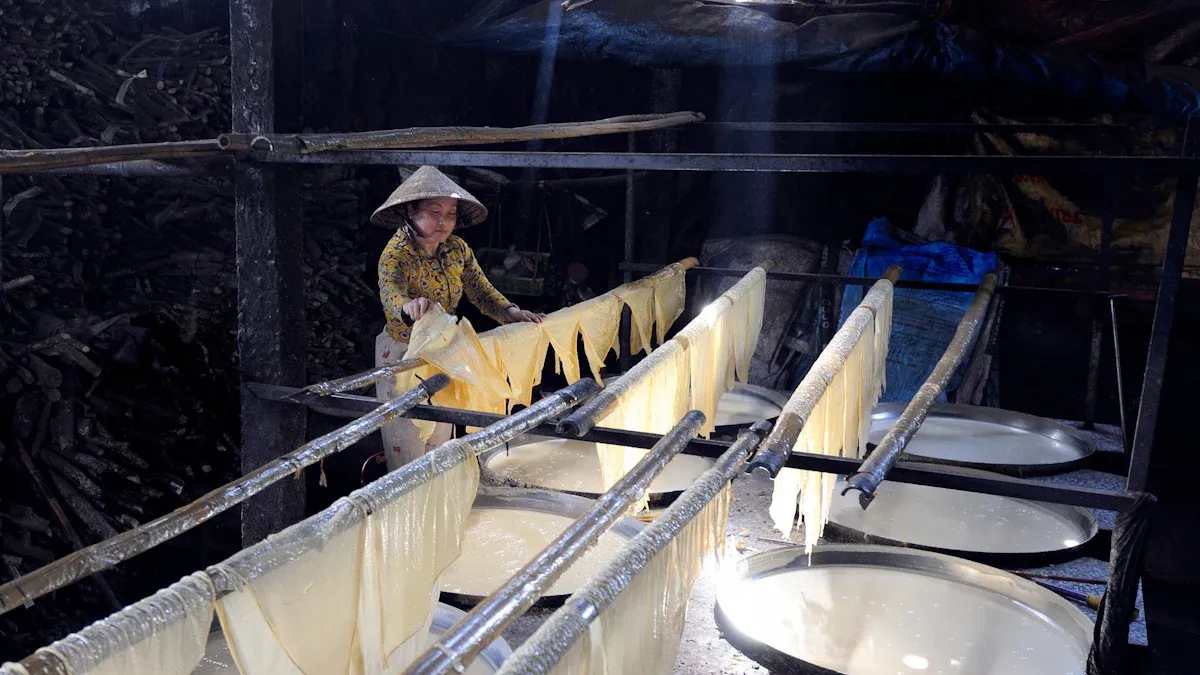Vietnam’s Factory Workers Are Living in Fear of Trump’s Tariffs

The announcement of new tariffs by President Trump has left Vietnam’s factory workers grappling with fear and uncertainty. For Nguyen Thi Tuyet Hanh, a 40-year-old line manager overseeing 138 workers, the possibility of increased duties on exports to the U.S. brings back memories of hardship. She recalls working two factory jobs six days a week to support her family when her husband lost his job in 2023. “My family lived through that difficult time — I don’t want to live it again,” she said.
The anxiety is widespread among Vietnam’s export-driven industries. Recent data reveals:
Nearly half of American apparel and footwear firms in Vietnam fear layoffs if new tariffs are imposed.
81% of surveyed firms expressed concern about the impact of potential tariffs on their businesses.
94% of manufacturers believe new duties would significantly strain their operations.
The hum of sewing machines on factory floors now carries a somber undertone, as workers and employers alike brace for the economic fallout.
Key Takeaways
Tariffs make factory workers in Vietnam worry about losing jobs.
Families struggle with money, leading to tough choices like stopping school or skipping healthcare.
Factory owners are trying to sell goods to more countries. This helps them depend less on the U.S. and avoid tariff problems.
Local groups are helping workers handle money troubles and stay steady.
Vietnam’s government is working on trade deals to protect the economy from tariffs.
The Human Cost for Factory Workers

Personal Stories of Struggle and Resilience
Factory workers in Vietnam face immense challenges as they navigate the uncertainties brought by tariff changes. Nguyen Thi Tuyet Hanh’s story highlights the resilience of these workers. She worked tirelessly in two factory jobs to support her family when her husband lost his job. Her determination ensured her children stayed in school despite the financial strain. Many others share similar experiences, demonstrating remarkable strength in the face of adversity.
The struggles of factory workers extend beyond financial hardships. They often endure long hours in demanding environments. Many workers, like Ms. Hanh, take on additional shifts or second jobs to make ends meet. Their resilience is evident in their ability to adapt to these challenges while continuing to provide for their families. However, the looming threat of tariffs adds another layer of uncertainty to their already difficult lives.
Emotional and Financial Challenges for Families
The emotional toll on families of factory workers is significant. Parents worry about providing basic necessities, such as food and education, for their children. The fear of job loss or reduced wages creates constant anxiety. This stress often affects the mental well-being of entire households, leading to strained relationships and emotional exhaustion.
Financial challenges compound these emotional struggles. Many families rely on a single income, making them vulnerable to economic shifts. A recent study highlights the vulnerability of informal workers in emerging economies, who face significant risks due to changes in supply chains caused by tariffs. Women, who are more likely to work in informal employment, are disproportionately affected. Disruptions in employment can also lead to increased social tension and instability in communities.
Impact Area | Description |
|---|---|
Vulnerability of Informal Workers | Informal workers in emerging economies face significant risks due to shifts in supply chains caused by tariffs. |
Gender Disparity | Women are disproportionately affected, being more likely to engage in informal employment. |
Social Stability | Disruption in informal employment can lead to increased social tension and instability in communities. |
The financial strain on families often forces them to make difficult decisions. Some parents pull their children out of school to save money, while others cut back on essential expenses like healthcare. These sacrifices highlight the far-reaching impact of economic policies on the lives of factory workers and their families.
Economic Fallout of Trump’s Tariffs
Decline in US Exports and Factory Closures
The imposition of tariffs has significantly disrupted trade between Vietnam and the United States. Factories that rely heavily on American demand face declining export orders, forcing many to scale back operations. This decline in exports has created a ripple effect, leading to factory closures and economic instability in Vietnam’s manufacturing sector.
Economic indicators reveal the extent of this fallout:
Economic Indicator | Description |
|---|---|
Goods Trade Balance | Measures the difference between U.S. exports and imports, indicating trade deficits. |
Manufacturing Employment Decline | Linked to misguided trade policies, resulting in factory closures and job losses in manufacturing. |
Tariffs led to a net loss of approximately 320,000 jobs in sectors reliant on imported inputs. | |
PMI and Export Orders | China's PMI fell below 50, indicating contraction, with new export orders dropping to 44.7, reflecting U.S. tariffs' impact. |
The decline in U.S. exports has left factory workers in Vietnam vulnerable. Many factories operate on thin profit margins, and the loss of American orders has pushed some to the brink of closure. This situation underscores the fragility of Vietnam’s export-driven economy.
Job Losses and Wage Cuts in Manufacturing
Tariffs have also triggered widespread job losses and wage reductions in Vietnam’s manufacturing sector. Factories that once thrived on steady demand from the U.S. now struggle to maintain their workforce. The apparel and textile industry, a cornerstone of Vietnam’s economy, has been particularly hard-hit.
Employment statistics highlight the scale of these losses:
Manufacturing employment peaked at 19.5 million in 1979 and fell to 12.9 million by 2024.
Significant declines occurred during 1980-1989 (7% decline) and 2000-2009 (33% decline).
The apparel and textile industry saw an 85% drop in employment from 1979 to 2019.
Wage cuts have compounded the challenges faced by factory workers. Many families, already living paycheck to paycheck, now struggle to afford basic necessities. The loss of income has forced some to pull children out of school or forego essential healthcare, deepening the social and economic impact of the tariffs.
Ripple Effects on Local Economies
The economic consequences of factory closures extend far beyond the manufacturing sector. Local economies, heavily reliant on factory workers’ spending, have experienced significant downturns. When factories close, the loss of jobs triggers a chain reaction, affecting businesses and services in surrounding communities.
Empirical studies provide insight into these ripple effects:
For every 100 jobs lost in durable manufacturing, approximately 744.1 indirect jobs are also lost.
In contrast, the loss of 100 jobs in retail results in only about 122.1 indirect job losses.
A $1 million drop in demand for durable manufacturing leads to 16.5 indirect jobs lost, compared to 10.6 in retail.
These figures highlight the disproportionate impact of manufacturing job losses on local economies. The closure of factories not only affects workers but also undermines the stability of entire communities. Small businesses, dependent on the spending power of factory workers, often face reduced revenues or closure themselves. This cascading effect underscores the broader economic risks posed by tariffs.
Factory Workers and Workplace Uncertainty

Working Conditions Amid Economic Pressure
Economic pressures have significantly impacted the working conditions of factory workers in Vietnam. Many workers face long hours, minimal rewards, and unsafe environments. Research on occupational health in developing countries highlights how economic globalization has shifted high-risk industries to these regions. This shift has led to inadequate safety regulations and increased health risks for workers. The "job demand-control" and "effort-reward imbalance" models further explain how high demands and low rewards contribute to physical and mental health issues, particularly for those in lower occupational roles.
The situation in Vietnam mirrors these findings. Factories operate on thin profit margins, forcing workers to endure grueling schedules to meet production targets. Nguyen Thi Tuyet Hanh, a factory worker, shared her experience of working two jobs to support her family after her husband lost his job. Her story reflects the broader struggles faced by many workers who must navigate challenging conditions while providing for their families.
Rising Fears of Job Insecurity
Job insecurity has become a growing concern among factory workers in Vietnam. The looming threat of tariffs has created widespread anxiety about potential job losses. Many workers fear that reduced export orders will lead to layoffs or wage cuts. This uncertainty affects not only their financial stability but also their overall well-being.
Labor market analyses from other regions provide insights into the effects of job insecurity. For example:
Fixed-term contracts in European countries, such as Germany, have increased job insecurity.
Young workers aged 27-30 report lower life satisfaction due to unstable employment.
These findings resonate with the experiences of Vietnamese factory workers, who face similar challenges in an uncertain economic climate.
Factory Owners’ Efforts to Retain Workers
Despite economic challenges, some factory owners are taking proactive steps to retain their workforce. For instance, Carolyn Hardy, a plant manager in Memphis, purchased a brewery facing closure to save over 200 jobs. Her determination transformed the facility into a successful business, demonstrating how leadership can mitigate job losses.
In Vietnam, factory owners like Tran Nhu Tung are exploring ways to maintain employment. Tung, the chairman of Thanh Cong, has sought to diversify export markets and negotiate with American customers to manage the impact of tariffs. His efforts reflect a commitment to preserving jobs and supporting workers during uncertain times.
Broader Economic Implications for Vietnam
Vulnerability of Export-Driven Industries
Vietnam’s economy relies heavily on export-driven industries, making it particularly vulnerable to external shocks like tariffs. The textile and garment sector, a cornerstone of the country’s manufacturing base, operates on razor-thin profit margins. A 46% tariff increase on exports to the U.S. has placed immense pressure on these industries. Many factories have already reduced production or frozen hiring to cope with declining orders.
The dependency on American demand exacerbates this vulnerability. Over a quarter of Vietnam’s economy depends on exports to the U.S., with processed industrial goods accounting for 88.2% of total shipments. This reliance leaves industries exposed to fluctuations in trade policies, creating a precarious situation for businesses and workers alike.
Impact on Vietnam’s Global Trade Position
The tariffs have also disrupted Vietnam’s global trade position. Recent trade statistics highlight the challenges:
Vietnam’s trade surplus dropped to USD 0.58 billion in April 2025, compared to USD 1.11 billion in April 2024.
Exports grew by 19.8% year-on-year to USD 37.45 billion, but imports surged by 22.9% to USD 36.87 billion.
For the first four months of 2025, the trade surplus narrowed significantly to USD 3.79 billion, down from USD 9.06 billion in the same period of 2024.
The U.S. remains Vietnam’s largest export market, contributing USD 43.4 billion in turnover. However, the new tariff system threatens this critical trade relationship. As Vietnam grapples with these challenges, its ability to maintain a competitive edge in global markets is at risk.
Long-Term Risks to Economic Growth
The long-term risks to Vietnam’s economic growth are significant. Tariffs not only disrupt immediate trade flows but also deter foreign investment. Businesses may hesitate to expand operations in a country facing uncertain trade policies. This hesitation could slow industrial growth and innovation.
Additionally, the narrowing trade surplus and rising import costs strain the economy. Vietnam’s Terms of Trade, which rose to 104.70 points in 2023, reflect a slight improvement. However, the historical average of 101.60 points underscores the fragile balance. Sustained tariff pressures could reverse these gains, undermining Vietnam’s economic stability and growth trajectory.
Responses to the Tariff Threat
Diversification of Export Markets
Vietnam’s industries are actively exploring new export markets to reduce reliance on the U.S. and mitigate the risks posed by tariffs. The Ministry of Industry and Trade has prioritized diversification, particularly for agricultural products. The EU has emerged as Vietnam’s third-largest export destination, with exports of rice, coffee, and seafood showing significant growth under the EU-Vietnam Free Trade Agreement. Emerging markets such as the Middle East, Africa, India, and Latin America are also gaining attention due to their increasing demand for food products.
Other industries, including manufacturing and energy, are adopting similar strategies. Sectors with diversified suppliers are better positioned to withstand disruptions caused by tariffs. However, industries heavily dependent on U.S. trade face greater challenges, highlighting the importance of expanding Vietnam’s global trade footprint.
Government Efforts in Trade Negotiations
Vietnam’s government has intensified trade negotiations to address the economic impacts of tariffs. Officials have engaged in discussions with key trading partners to secure favorable agreements. For example, Vietnam’s leaders have proposed reducing tariffs on American imports to zero, aiming to foster reciprocal trade benefits.
Global trade negotiations offer valuable lessons. The renegotiation of NAFTA into the USMCA took over a year, demonstrating the complexity of such agreements. Similarly, the Phase One trade deal between the U.S. and China required extensive discussions before its signing in January 2020. Vietnam’s proactive approach reflects its commitment to minimizing tariff-related disruptions and maintaining economic stability.
Studies underscore the broader implications of tariffs. Research from the IMF suggests that reversing tariffs could significantly boost economic output, emphasizing the importance of effective trade policies. Vietnam’s efforts in this area are critical to safeguarding its export-driven economy and supporting factory workers.
Grassroots Support for Factory Workers
Grassroots initiatives are playing a vital role in supporting factory workers during these uncertain times. Community organizations and local businesses have stepped up to provide assistance, including financial aid and job placement services. These efforts aim to alleviate the economic strain on workers and their families.
Factory owners are also contributing to these initiatives. Leaders like Tran Nhu Tung are working to retain employees by diversifying export markets and negotiating with customers. Such measures reflect a shared commitment to preserving jobs and ensuring the well-being of workers.
Grassroots support highlights the resilience of Vietnam’s communities. By fostering collaboration between businesses, workers, and local organizations, these efforts help mitigate the impact of tariffs and strengthen the country’s social fabric.
The tariffs proposed by President Trump have deeply affected Vietnam’s factory workers, creating economic hardships and emotional strain. Families face reduced incomes, job losses, and uncertainty about the future. Despite these challenges, Vietnam’s workforce has shown remarkable resilience. Workers and industries continue to adapt by diversifying markets and seeking innovative solutions.
The ongoing efforts by the government, factory owners, and grassroots organizations are crucial. These initiatives aim to stabilize the economy and protect livelihoods. Vietnam’s ability to navigate these challenges will determine its long-term economic stability and growth.
FAQ
What are the main industries affected by Trump’s tariffs in Vietnam?
Vietnam’s textile, garment, and footwear industries face the greatest impact. These sectors rely heavily on exports to the U.S. and operate on thin profit margins. Tariffs disrupt their supply chains, reduce orders, and force factories to cut jobs or freeze hiring.
How do tariffs affect factory workers’ daily lives?
Tariffs create job insecurity and financial strain for workers. Many face wage cuts or layoffs, leading to difficulties in affording basic necessities like food, education, and healthcare. Families often experience emotional stress due to the uncertainty surrounding their livelihoods.
Why is Vietnam’s economy vulnerable to U.S. tariffs?
Vietnam’s economy depends on exports, with over a quarter of its GDP tied to U.S. demand. Tariffs disrupt trade flows, reduce export orders, and weaken industries like manufacturing. This reliance on a single market increases the country’s economic vulnerability.
What steps are factory owners taking to protect workers?
Factory owners are diversifying export markets and negotiating with customers to manage tariff impacts. Some prioritize retaining employees by increasing production efficiency or exploring alternative trade regions. These efforts aim to minimize job losses and stabilize operations.
How is the Vietnamese government responding to the tariff threat?
The government is intensifying trade negotiations and proposing tariff reductions on American imports. Officials are also encouraging industries to explore new markets, such as the EU and Middle East, to reduce reliance on the U.S. and mitigate economic risks.
See Also
Exploring How Global Trade Policies Shape National Economies
Address Supply Chain Risks Now To Safeguard Your Business
Separating Fact From Fiction In High-Tech Manufacturing Automation
Maximizing Efficiency In Your Automotive Supply Chain Operations
